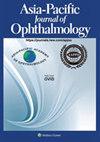Review of Visualization Approaches in Deep Learning Models of Glaucoma
IF 4.5
3区 医学
Q1 OPHTHALMOLOGY
引用次数: 0
Abstract
Glaucoma is a major cause of irreversible blindness worldwide. As glaucoma often presents without symptoms, early detection and intervention are important in delaying progression. Deep learning (DL) has emerged as a rapidly advancing tool to help achieve these objectives. In this narrative review, data types and visualization approaches for presenting model predictions, including models based on tabular data, functional data, and/or structural data, are summarized, and the importance of data source diversity for improving the utility and generalizability of DL models is explored. Examples of innovative approaches to understanding predictions of artificial intelligence (AI) models and alignment with clinicians are provided. In addition, methods to enhance the interpretability of clinical features from tabular data used to train AI models are investigated. Examples of published DL models that include interfaces to facilitate end-user engagement and minimize cognitive and time burdens are highlighted. The stages of integrating AI models into existing clinical workflows are reviewed, and challenges are discussed. Reviewing these approaches may help inform the generation of user-friendly interfaces that are successfully integrated into clinical information systems. This review details key principles regarding visualization approaches in DL models of glaucoma. The articles reviewed here focused on usability, explainability, and promotion of clinician trust to encourage wider adoption for clinical use. These studies demonstrate important progress in addressing visualization and explainability issues required for successful real-world implementation of DL models in glaucoma.
青光眼深度学习模型中的可视化方法回顾。
青光眼是导致全球不可逆转性失明的主要原因。由于青光眼通常没有任何症状,因此早期检测和干预对于延缓病情发展非常重要。深度学习(DL)已成为帮助实现这些目标的一种快速进步的工具。在这篇叙述性综述中,总结了用于呈现模型预测的数据类型和可视化方法,包括基于表格数据、功能数据和/或结构数据的模型,并探讨了数据源多样性对于提高深度学习模型的实用性和普适性的重要性。举例说明了理解人工智能(AI)模型预测并与临床医生保持一致的创新方法。此外,还研究了从用于训练人工智能模型的表格数据中增强临床特征可解释性的方法。重点介绍了已发布的包含界面的 DL 模型,这些界面可促进最终用户的参与,并最大限度地减少认知和时间负担。回顾了将人工智能模型整合到现有临床工作流程的各个阶段,并讨论了所面临的挑战。回顾这些方法可能有助于为生成成功集成到临床信息系统中的用户友好界面提供信息。本综述详细介绍了有关青光眼 DL 模型可视化方法的关键原则。本文综述的文章重点关注可用性、可解释性以及提高临床医生的信任度,以鼓励在临床使用中更广泛地采用可视化方法。这些研究表明,在解决可视化和可解释性问题方面取得了重要进展,这些问题是在现实世界中成功实施青光眼 DL 模型所必需的。
本文章由计算机程序翻译,如有差异,请以英文原文为准。
求助全文
约1分钟内获得全文
求助全文
来源期刊

Asia-Pacific Journal of Ophthalmology
OPHTHALMOLOGY-
CiteScore
8.10
自引率
18.20%
发文量
197
审稿时长
6 weeks
期刊介绍:
The Asia-Pacific Journal of Ophthalmology, a bimonthly, peer-reviewed online scientific publication, is an official publication of the Asia-Pacific Academy of Ophthalmology (APAO), a supranational organization which is committed to research, training, learning, publication and knowledge and skill transfers in ophthalmology and visual sciences. The Asia-Pacific Journal of Ophthalmology welcomes review articles on currently hot topics, original, previously unpublished manuscripts describing clinical investigations, clinical observations and clinically relevant laboratory investigations, as well as .perspectives containing personal viewpoints on topics with broad interests. Editorials are published by invitation only. Case reports are generally not considered. The Asia-Pacific Journal of Ophthalmology covers 16 subspecialties and is freely circulated among individual members of the APAO’s member societies, which amounts to a potential readership of over 50,000.
 求助内容:
求助内容: 应助结果提醒方式:
应助结果提醒方式:


